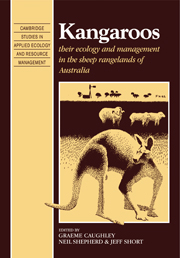Book contents
- Frontmatter
- Contents
- Preface
- Dedication
- THE STUDY AREA IN CONTEXT
- 1 Introduction to the sheep rangelands
- 2 The environment of the Australian sheep rangelands
- 3 The effect of weather on soil moisture and plant growth in the arid zone
- 4 Plant dynamics
- 5 The diet of herbivores in the sheep rangelands
- 6 Factors affecting food intake of rangelands herbivores
- 7 The mobility and habitat utilisation of kangaroos
- 8 Kangaroo dynamics
- 9 Condition and recruitment of kangaroos
- 10 Ecological relationships
- 11 Options for management of kangaroos
- Appendices to Chapter 8
- REFERENCES
- Author index
- Subject index
9 - Condition and recruitment of kangaroos
Published online by Cambridge University Press: 05 November 2011
- Frontmatter
- Contents
- Preface
- Dedication
- THE STUDY AREA IN CONTEXT
- 1 Introduction to the sheep rangelands
- 2 The environment of the Australian sheep rangelands
- 3 The effect of weather on soil moisture and plant growth in the arid zone
- 4 Plant dynamics
- 5 The diet of herbivores in the sheep rangelands
- 6 Factors affecting food intake of rangelands herbivores
- 7 The mobility and habitat utilisation of kangaroos
- 8 Kangaroo dynamics
- 9 Condition and recruitment of kangaroos
- 10 Ecological relationships
- 11 Options for management of kangaroos
- Appendices to Chapter 8
- REFERENCES
- Author index
- Subject index
Summary
Introduction
In this chapter body condition, nutritional intake, and recruitment of red and western grey kangaroos are related to trends in weather and vegetation. Some data relating to condition and recruitment of sheep are included for comparison. Body condition is also assessed as a wildlife management tool, with particular emphasis on assessment of kangaroo populations.
The kangaroo data are part of a long-term investigation that will not terminate until February 1986. Findings discussed here are mostly drawn from data collected between mid-1982 and the end of 1984. Methods will be published in detail elsewhere, but the essential information is provided below.
From June 1982 until December 1984 female kangaroos were sampled every three months on Kinchega and Tandou. Samples comprised 20 red kangaroos and 20 western grey kangaroos from Kinchega, and 20 red kangaroos from Tandou. An additional sample of 20 red kangaroos was taken on Kinchega midway between these three monthly samples; on one occasion (January 1983) this was extended to include 20 western grey kangaroos. These additional samples of red kangaroos from Kinchega were discontinued after February 1984 as was all sampling on Tandou. There are thus substantially more data on Kinchega reds than on either Tandou reds or Kinchega western greys. Western greys were not sampled on Tandou because they were at too low a density for samples to be readily obtained.
- Type
- Chapter
- Information
- KangaroosTheir Ecology and Management in the Sheep Rangelands of Australia, pp. 135 - 158Publisher: Cambridge University PressPrint publication year: 1987
- 10
- Cited by



